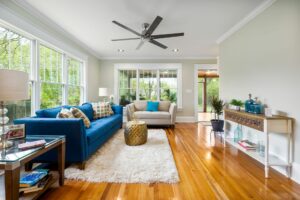When designing a master bedroom, one of the most important factors to consider is the size of the space. From accommodating furniture to providing enough room for movement, the size of a master bedroom can impact the overall look and feel of the room. In this blog post, we’ll take a closer look at the average master bedroom size, as well as what to consider when designing for smaller and bigger spaces.
What is the Average Master Bedroom Size?
According to the National Association of Home Builders, the average size of a master bedroom in a new home is approximately 309 square feet. This includes both the main sleeping area as well as any additional sitting or lounge areas.
However, it’s important to note that the size can vary greatly depending on factors like the overall size of the home, the layout of the space, and the personal preferences of the homeowner.
What is the Average Master Bedroom Size for Smaller Spaces?
For smaller homes or spaces, the average master bedroom size may be closer to 200-250 square feet. This can still provide ample space for a bed, storage, and even a small seating area.
When designing a smaller master bedroom, it’s important to focus on maximizing storage and minimizing clutter. Built-in storage solutions like under-bed drawers or shelving can help make the most of limited space, while light, neutral colors can help make the room feel more open and airy.
What is the Average Master Bedroom Size for Bigger Spaces?
For larger homes or spaces, the average master bedroom size may exceed 400-500 square feet or more. This allows for a more spacious layout with room for additional furniture like a sitting area or even a fireplace.
When designing a larger master bedroom, it’s important to consider the overall flow and layout of the space. Creating distinct zones for sleeping, lounging, and getting ready can help make the room feel more functional and organized.
It’s also important to consider the scale of furniture and decor when designing a larger master bedroom. Larger pieces like a king-sized bed or oversized armchairs can help fill the space without overwhelming it, while a large area rug can help tie the room together.
In conclusion, the size of a master bedroom can play a significant role in the overall look and feel of the space. While the average master bedroom size may be around 309 square feet, it’s important to consider the specific needs and preferences of each homeowner when designing for smaller or larger spaces. By taking into account factors like storage, layout, and furniture scale, it’s possible to create a space that feels both functional and stylish, no matter the size.








